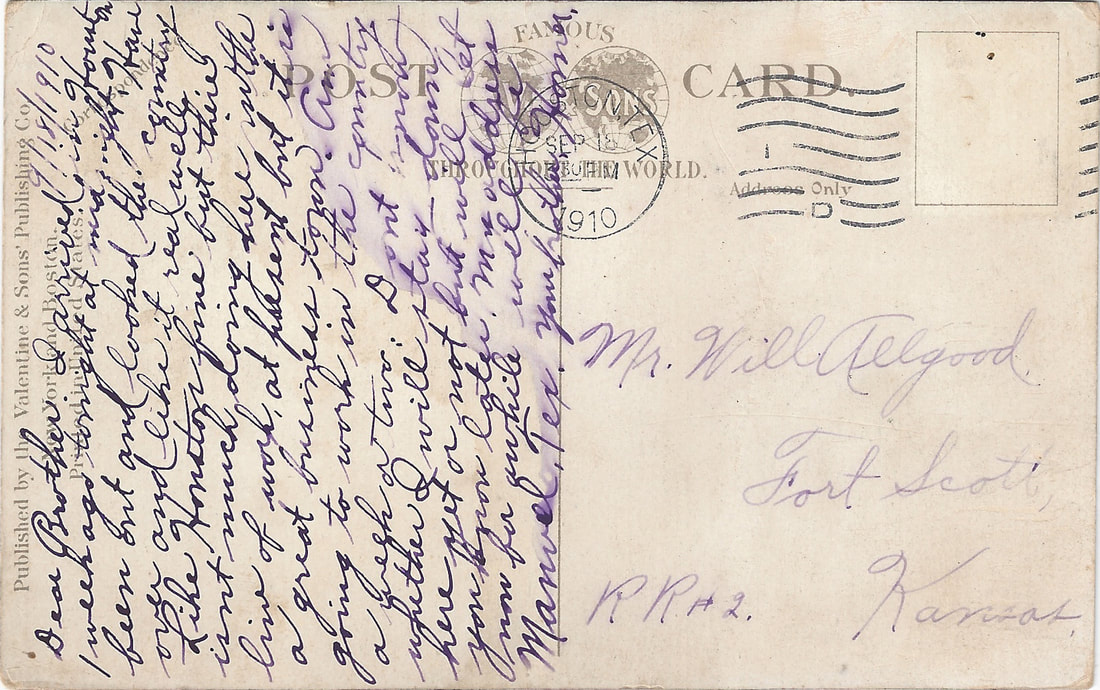Grand Central Station
|
10 September 1918: Rail traffic into Houston, "Where 17 railroads meet the sea," often brought passengers into Grand Central Station above the banks of Buffalo Bayou a few blocks northwest of downtown. Passengers from across the country on The Southern Pacific line, under the local control of the H&TC [Houston and Texas Central RR] could stay at the Brazos Hotel across Washington Street, or take an electric trolley downtown for fancier hotels. This station was built in 1887 and was remodeled in 1906 and 1914. Southern Pacific demolished this station in 1934 and built a much larger building on the site, this latter structure demolished in 1959 and replaced by the Houston Central Post Office.
|
2 August 2013: Access to this site requires a precarious hike down the railroad tracks from UH downtown, dodging the occasional freight train, and chatting with curious homeless men wondering what brings a non-transient to so derelict a spot. The Houston Central Post Office at 401 Franklin was still in operation when this re-photograph was taken, but it has been closed now for several years. Trucks once unloaded mail at multiple bays, and the warehouses were a 24 hour operation as mail entered and left through its gates. Where passengers once de-boarded trains and headed for downtown Houston or hotels closer to the trains, now there is a stillness punctuated only rarely by the howls of trains on their way somewhere else. Tiny Amtrak station at 902 Washington built in 1960 is just past the overpasses for I-45, a sad structure busy only three days a week, too distant to be discernible.
|
|
Postmarked: 18 September 1910; Houston, Tex. "D"
Stamp: Removed To: Mr. Will Algood Fort Scott, Kansas. RR#2. Message: Dear Brother. I arrived in Houston 1 week ago tonight at midnight. Have been out and looked the country over and like it real well Like Houston fine but there isnt much doing here in the line of work, at present but it is going to work in the country a week or two. Dont know whether I will stay down here yet or not but will let you know later. My address for awhile will be Manvel, Tex. Your brother, Homer. |
Homer Clyde Allgood was 29 when he sent this card to his older brother William Brown Allgood, 37. They were sons of Charles Alexander Allgood and Mary Ann Moore of Mahaska County, Iowa, farmers in the rich lands about halfway between Des Moines and Iowa City. Homer’s choice of work departed from the family's history in agriculture, and was evidently in Houston to test the waters of commerce. He settled in Manvel about 25 miles south of downtown Houston. Adjacent to Manvel was Iowa Colony, a small community founded in 1908 by the Immigration Land Company, a Des Moines land development company, and Homer may have been drawn there through this company’s outreach efforts.
In 1917 prior to Houston he had been in Rock Creek a few miles northeast of St. Paul, MN, seeking his fortune there as well. He did not stay long in Minnesota, and apparently not long In Texas either, and by 1919 married Caroline B., a girl from Kansas whose Illinois family is as yet undiscovered. Homer became a traveling accountant and he and Caroline moved frequently, settling near Portland, OR by 1930, and Seattle at least 1935-1951. They never had children. They retired to Medford, OR where Homer died in 1965 and Caroline in 1972; they are buried in Siskiyou Memorial Park there. Homer’s brother lived quite a different kind of life. After moving from his childhood home in Mahaska County, IA to Bourbon County, KS, he married Ethel Holmes in 1909 and began to farm there. Their only child, Leonard, was born in 1910, and their small family remained on the farm in Osage Township on the border of Missouri for more than 60 years. Ethel died there in 1969, Will in 1972. They are buried in Maple Grove Cemetery in Fort Scott, Bourbon County, KS, as was their son, Leonard (1910-1985) and his wife Wanda (1912-1983). |

